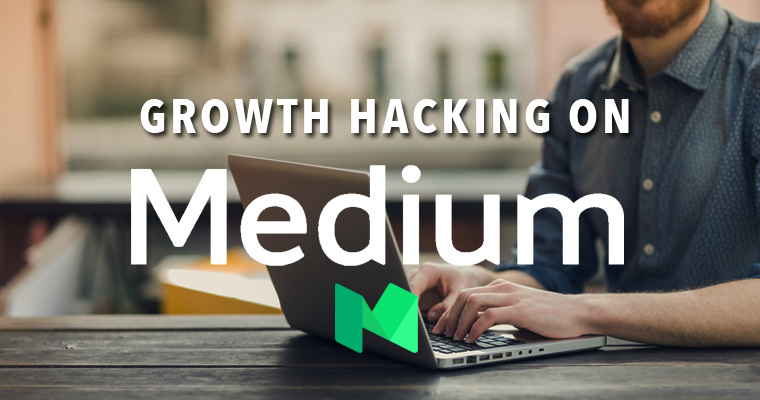When you publish a stellar piece of content, there’s a good chance you want it to actually engage your audience. If you’ve done your job, you’ll most likely get people to share, comment, and interact with your content. And, if you’re lucky, you’ll get a few backlinks to your content. But, what happens if you’re starting from scratch? Or, if you’re looking to expand your content strategy into other realms of storytelling?
Imagine having the potential to reach 649k followers with your content by only hitting publish in Medium. Instead of having to build your brand or new content strategy with little-to-no audience, you’re able to grow by piggybacking onto Medium’s user base.
What makes Medium different from other companies is that it’s not a real social network or publishing platform. So, what is Medium? The answer is simple: it’s both a social channel and a publisher. Medium is a place for brands (and individuals!) to publish stories and distribute content to an audience that’s already ready to engage.
Jay Baer, calls Medium “…LinkedIn’s cool younger brother who wears concert T-shirts all the time, but also checks the Dow Jones average on his iPhone.” Medium is getting much bigger very quickly, and I’m starting to see a shift in brands looking to publish there. Medium’s founders call it a place for ideas.
Here’s What I Found
Some notable data points for Medium:
- In December 2015, according to SimilarWeb, Medium received 54.3 million visitors. Today, as of May 2016, Medium has 61.7 million visits.
- U.S. users have grown to 34.4% of the overall users (and the global population is building with 16.3% coming from India).
- In April 2015, Native Advertising stated, regarding the demographics of Medium, that “95% of Medium’s readers are college graduates, and 43% of them earn six figures or more. Even better, from an advertiser standpoint, these readers are also young, with half of them in the coveted 18-34 demographic and 70% of them being under the age of 50.”
Today, I’m going to show you how brands can create value within Medium using the content and tactics you already have at your fingertips.
Yep, that’s right! No need to spend six months testing a new strategy—chances are, you’re already engaging and sharing content on other similar platforms that can backup your direction on Medium. This way, you can save time (and money!) and drive positive growth for your business.
How to Create a Growth Strategy for Medium
Learn from Your Medium Dashboard
What was the one discovery that took your content to the next level?
For me, it was the realization that using data to build content increases shares, comments, reads, and overall interaction.
I can point to many “aha” moments in my career, but learning these lifelong lessons came with a lot of hard work and awkward experiences. That’s why I’m sharing these insights into Medium’s dashboard that helped me raise the bar!
Medium tracks four stats for your stories: views, reads, read ratio, and recommendations in 30-day segments.
Here’s a quick overview of what these metrics mean:
- Views: How many people saw your story.
- Reads: How many people read your story all the way to the end.
- Read Ratio: How many people read your full story compared to those who only viewed it.
- Recommendations: The number of people who recommend your story.
Medium, like other search engines and social channels, uses its algorithm to determine how many people read your blog post versus people who simply view it to help your story rank on the homepage. Ev Williams, the founder of Medium, mentioned read ratio affects how your post is ranked and found within Medium. This factor provides amazing value to brands by telling them if people are actually reading the content they’re publishing. This, in turn, leads to better writing.
Leveraging your existing Medium data to unlock the value in your Medium content begins with understanding your data.
I recommend starting with your current assumptions based on your analysis of your competitors and top performing stories on Medium. Challenge yourself to identify what type of content powers the homepage and what stands out most to you. Every platform is different. What may work on your blog may not work on Medium.
Develop a Consistent Content Strategy and Stick to It
Every website owner has dreams for his or her company. My goal for the content I’m publishing on Medium is to make a long-term impact on my business and people around the world. Success on Medium means having to sustain some degree of content. And, the greatest challenge for publishing content? Staying the course. To build an active search profile and follower count, you must remain consistent. This means a lot of hard work and grit. I’m talking 3-to-6 months of regular, high-quality content on a set schedule before you can see any meaningful engagement take place.
It works—you will start to generate traffic and a higher quality of leads if you stay the course. Once you start to see an increase in traffic and leads, then you can make your case for scaling the content.
To help get you started, I’d suggested putting together a content calendar for Medium. We use a Google spreadsheet as our content calendar at SEJ. Once you’ve gathered your information, let the magic begin.
Here are a few ways to start, sustain, and make the most of your content calendars on Medium with help from the Head of Product Science at Medium, Mike Sall:
- Peak-time posts (between 6am-3pm PST) tend to be longer
- Peak-time posts tend to take more time to write (per word)
- Peak-time posts tend to have authors with more followers
Kiki Schirr, co-founder of Fittr, publishes to her Medium daily. She told Social Media Examiner that “By posting a small piece each day I was able to reach 10,000 subscribers to my publication in 66 days. I think that’s an exciting prospect for marketers.”
Know What Type of Content Performs Well on Medium
If you’re coming from a place of corporate communications where structure guidelines of AP style are a prerequisite for emails and you’re only allowed one exclamation point per year, then Medium is not the platform for you.
The content on Medium that wins tells a story, explores a vulnerable side, evokes emotion, or sparks controversy. Here are a few examples of my favorites:
- Confessions of an Ex-Tech Journalist by Bekah Grant, a former writer at VentureBeat
- You Will Always Suck, Until You Do This by CamMi Pham, Marketer & Partner of Think Renegade
- Ten More Minutes by Anne Branigin, writer
These emotional cues are especially important when repurposing old content. Old content that does well on Medium should tell a story. Also, don’t forget to add the rel=canonical tag to your original post to avoid duplicate content issues on Medium. Reposting old content does work, just take a look at Unbounce. Unbounce discovered that Medium resulted in an additional 144 views.
Also, while there is no ideal word-count for stories on Medium, the optimal post time is suggested at 7 minutes. Make sure to A/B test short and long-form content to see what works best for your audience.
A few good brands to learn from:
Bonus Tip: Tap the heart for more love! By asking your readers to recommend your story at the end of each post helps you get more views with their audience. Don’t be afraid to ask.
Formatting Features
User experience boils down to a combination of content and web design flow—what’s the best way to make an awesome vibe for the user on my website. It’s not about cool features or trendy gimmicks. We can see this transition to user experience needs with sites like Airbnb, Uber, Evernote, and so many more. Medium allows its publishers to focus on the content, with subtle design changes.
Lots of white space, big photos, and clean typography are already built into the system. In an ever-growing market landscape where we’re all fighting for space, utilizing Medium’s formatting features may be the best option to get your content to stand out. Everything from Beautiful Stories offers great examples for how to implement formatting on Medium.
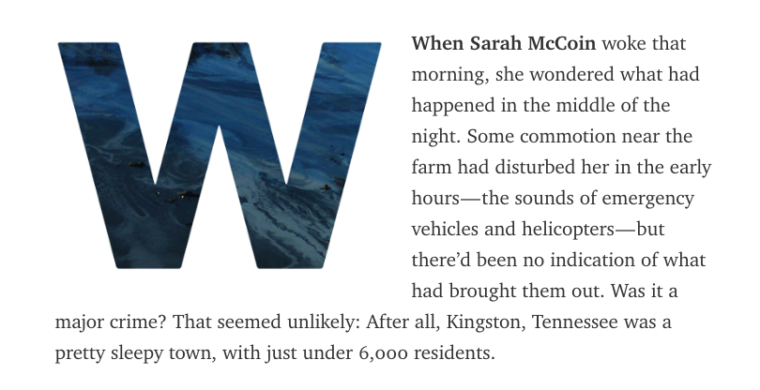
I recommend creating a style guide for your Medium content. Here’s what I’ve included in my personal Medium style guide:
- a written manifesto of my own brand
- a direction for my work on Medium
- information about logos (with links to where to download); color palette; a tone of voice
- photography guidelines
- copywriting guidelines
- additional optimization tips (using header tags, hyperlinks, tagging people, etc.)
Bonus Tip: Use Google’s UTM builder to set-up tracking when linking back to content on your website. This is essential for tracking your calls-to-action to find out what’s working and what’s not.
Remember, designing a clean user experience with your content can go a long way. Given what I know about the power of design, what can publishers do to create a personalized experience within Medium?
Some of my favorite examples:
- How Google is Remaking Itself as a “Machine Learning First” Company by Steven Levy, Editor of Backchannel
- The Social Media Automation Strategy Every Marketer Needs by Keven Lee, Content Crafter at Buffer
- Meetings That Don’t Suck by Ken Norton, Partner at Google Ventures
- Use These 8 Marketing Tools to Grow Your Startup 🚀 by Product Hunt
Content Upgrades
You want to create excellent content, not marginally okay pieces of content. When your content’s not really what readers are looking for, you still have the opportunity to generate an additional interaction by pointing them toward a content upgrade.
The Nib, for example, always includes a shout out to their weekly newsletter at the bottom of their stories. This results in long-term lead capture regarding emails.

Or, check out how HubSpot’s ReadThink embeds a SoundCloud podcast.
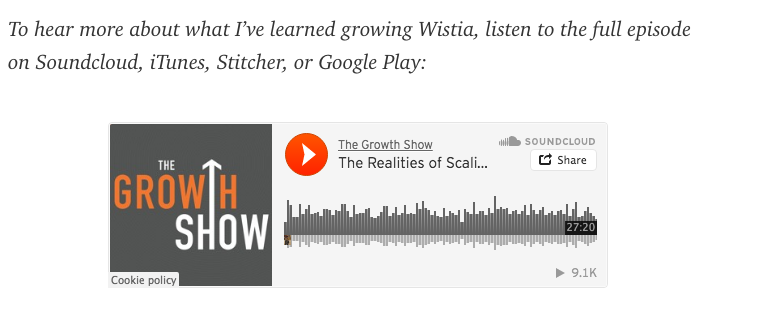
Or, even better, what about this CTA with a gif that Free Code Camp dropped in at the bottom of the story.
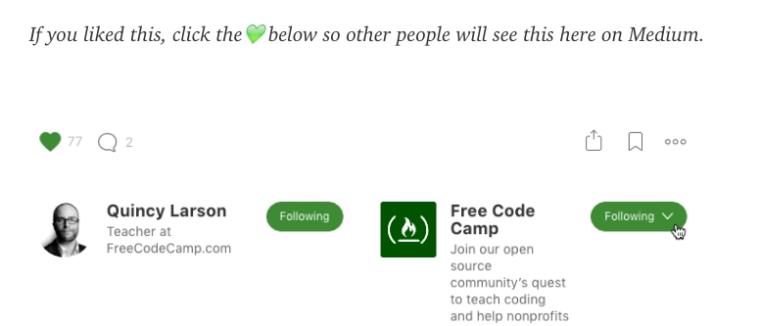
You can also strategize about who you’re mentioning in your story. By mentioning other people, you give yourself an additional opportunity to get your story shared by their audience.
Another cool option is to do something like Code Like A Girl does by integrating links to their other Medium stories within the copy.

You can also ask your readers to tweet individual sentences of your story. You can embed these text shots into the copy. Medium says that stories with text shots have 3–5× more engagement than stories without them.
And, let’s not forget about free bonus content sprinkled generously throughout your post like you see here.

When people are forced to interact with your content, you’re naturally going to see users stay on your content for a longer period. During my time on the marketing team for Noodle, for instance, we’d always incorporate visuals as content upgrades. These can look something like this on Medium:
Ideally, you always include a high-quality photo (900 x 900 pixels) at the top of the story. Like this photo from Sleigh Dogs.

You can also create image grids by holding Ctrl/⌘ or Shift while selecting image files.
The ultimate goal is to help your story become so popular that you’d have a chance to be featured as a Top Story or be chosen for the Medium Staff email digest.
Bonus Tip: Rabbut is an awesome subscription box tool you can use to capture emails on Medium. They have a free plan, and their premium plan is only $10. How much is a lead worth to you?
Tags
Often, publishers just ignore the tag option when sharing their story for the first time. These small touches can place your content under the scrolling eyes of your ideal customer. You can choose up to 5 tags, so use them all. Once your story is published, it will be distributed to those tags you want. It’s an easy way to get your content found by the right customer.
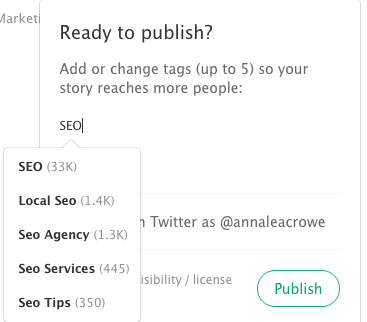
When using tags, consider the reach of that tag. The number represents the people who are following the tag. Yes, it might be tempting to blow it out of the water by reaching a million users with your tags, it’s also a very competitive space. Think of this like targeting your Facebook ads or Twitter ads. You want to target an audience that is more likely to read your content. I recommend using a mix of both high (one tag) and low (two tags).
Collaborate with Others Before Publishing
You created an amazing story for your Medium audience; it’s locked and ready to publish. But, wait there’s one more step before you hit publish.
Medium allows publishers to get feedback on drafts from other authors. By sharing your story in the editing phase, you’re able to create another touch-point before launching your article. This process of sharing your article before it’s published is similar to performing pre-publish outreach for link building.
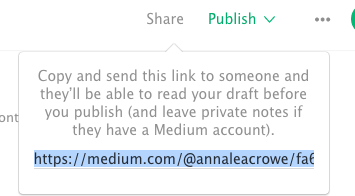
Medium’s share tool works similar to Google docs.
Bonus Tip: Notes on Medium are an excellent way to share feedback when you share your draft with someone. It’s like the Google docs comments area.
Engage with Other Users Content
At some point, throwing mud (or “sh*t” as Hannah Smith, a content strategist from Distilled would say) on the wall to see if it sticks will make for a great way to funnel your content into what works and what doesn’t, but it’s not a sustainable content strategy. At some point you’ve got to grow your readers, live by them, or die without them.
The best part about responding to other’s content on Medium? Your responses turn into stories. Ev Williams explains in more detail the reasoning behind the response feature. The short version: No one will see your responses unless they follow you or someone recommends your response.
This shouldn’t restrict you from commenting, but embrace it with one goal: constant and never-ending engagement with the writer and, potentially, their following.
Elizabeth Tobey, Head of Community Management at Medium, is someone worth following to read her responses. Each is authentic, meaningful, and written as if it were to become a story. Here is a snippet of one of her responses below:
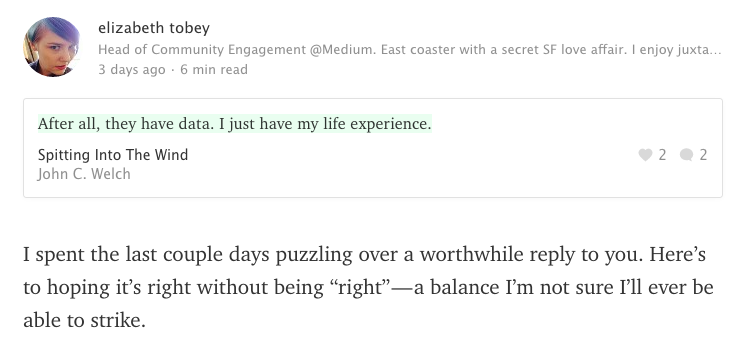 Another way to engage with other’s content on Medium is by highlighting your favorite quote or phrase from their story.
Another way to engage with other’s content on Medium is by highlighting your favorite quote or phrase from their story.

Or, recommend it using the heart icon at the bottom.
And remember to reply and interact with your content once users start engaging.
Feature Your Story
Annoyed by your latest responses on Medium publishing on top of your latest stories? Yeah, I’ve been there. After you publish a fresh piece of content on Medium, head over to your profile and click the down arrow. Here, you’ll be able to see the option to “feature at the top of your profile”. This allows readers that land on your Medium homepage to hit your favorite content first.
Here it is in action on Lauren Holliday’s Medium profile:
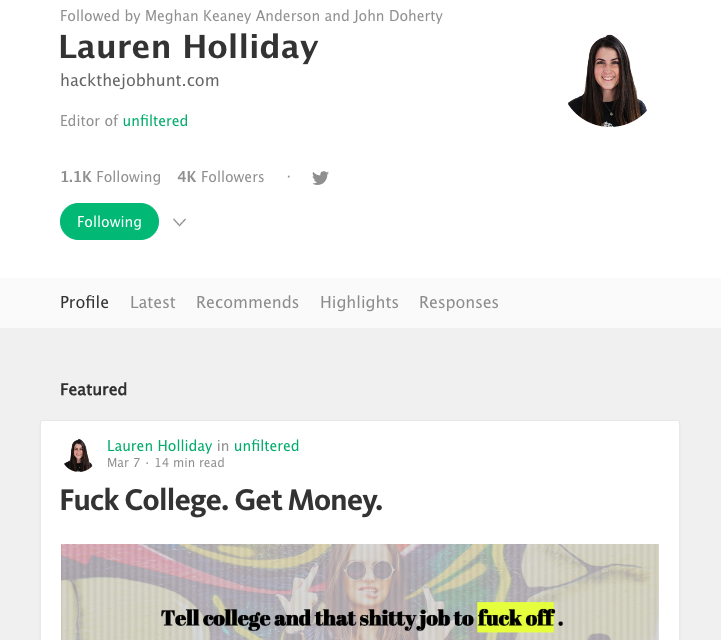
Submit Content to Publications
Finding the right publication to submit your story to on Medium can make or break your reach. Luckily the awesome people over at Grow and Convert have put together a spreadsheet of all the Medium publications, with follower counts and descriptions, to help us determine which publication to submit to. Here is the article by Grow and Convert to get your spreadsheet of Medium publications.
A few notable publications:
- Matter
- Editor’s Picks
- What I Learned Today
- The StartUp
Submit with caution! You have to be selective about which publications you’re submitting to. Compare the number of followers with the theme of the publication before submitting. Remember, you want to gain the right type of exposure.
Share Your Medium Story in Other Communities
It isn’t enough today to just write an amazing piece of content. Today, you have to share it on social, bookmark it, and post it in other communities. Publishing a story on Medium is no different than publishing a post on your website blog. It still needs to be shared to help drive traffic to it.
Here are some popular communities:
- Inbound.org
- StumbleUpon
- Digg
Create Letters for Your Followers Inbox
Letters launched in June 2015 as a way to connect your publication with its followers on a regular basis by delivering your content straight to their inbox. Letters also serve as a post so that it can be recommended, highlighted, and shared. Ideally, you would want to have a separate content strategy for your Letters because they are being received as an email. Emails are typically more conversational and short.
All your Medium Letters should include one call-to-action (CTA) to subscribe your email list to your Medium’s stories. Be specific and direct about how you want them to subscribe by adding links and landing pages. Also, you can embed a tweet with a lead capture card to get users to opt-in for an email follow-up.
Here is an example of a Letter sent to your inbox:
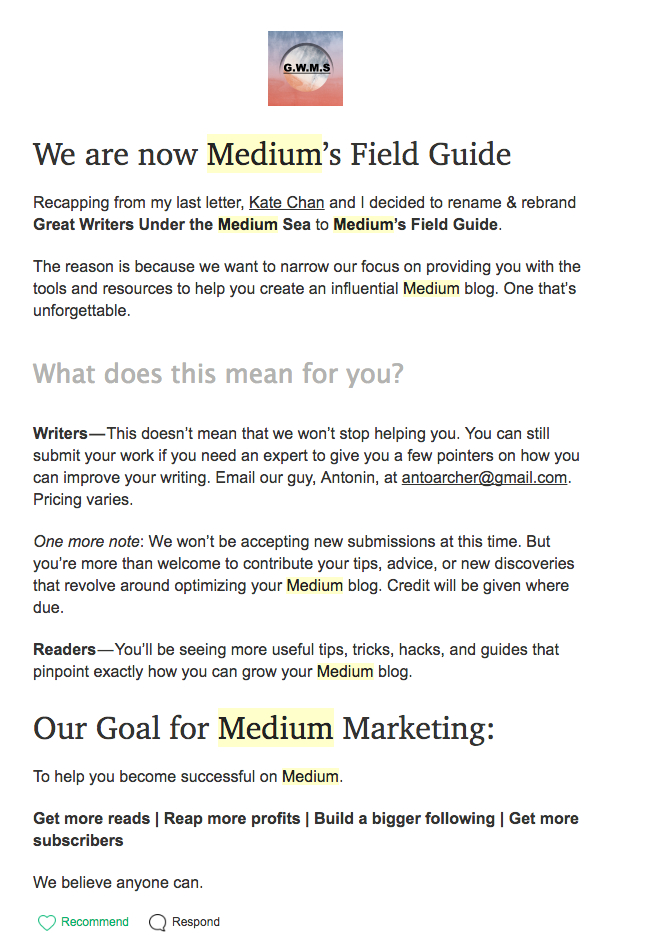
And here’s what this same letter looks like in your browser.
Start Prepping for an Ad Budget
Medium recently announced the Revenue Beta Testing program. They are rolling Promoted Stories and Memberships for a few select publishers and bloggers. Medium chooses these publishers based on their level of engaged readership. Brand partners for Promoted Stories include Bose, SoFi, Nest, Intel, and Volpi Foods.
For Memberships, Medium will be launching member-only content and perks to readers of certain publications. These publications include Serious Eats, True Magazine, and Great Jones Street.
As you can see, Medium is preparing to compete in the ad space and if you’re interested in continuing to publish content there, I’d recommend setting aside some funds for when this goes public.
Medium Will Continue to Evolve
Because Medium is still growing, every new product release can have a dramatic impact on how brands publish on Medium. For the most part, Medium appears to be harnessing the power of views, reads, and recommendations, but that could change. Some changes have already ignited loyalty amongst some of the top brands as I mentioned above.
Medium still has a long way to go. For example, while their interface has a gorgeous design and great user experience, there are still little opportunities for brands to control how their content is being perceived.
This is a glaring omission for a company that prides itself on “People create better things together.” This is one of the biggest reasons why Paul Jarvis left the Medium.
Medium has started to address these gaps by introducing new product releases like the collaborative writing tool and allowing brands to use their domains like HubSpot’s ReadThink. I also recognize that Medium is creating a genuinely unique product that fulfills a void we needed in marketing, but really, Medium is showing us how we’re all going to consume content in the future.
All in all, my takeaway from this is that sharing your content and diversifying your content distribution channels keeps your content front-of-mind for yourself and your followers. So, I’m going to test it. Of course, talk is not enough. I will continue to report regularly on my status and I’ll continue to share new Medium tips as I go.
Do you have lessons from your Medium strategy? Comments on the advice you read? Continue the conversation below in the comments.
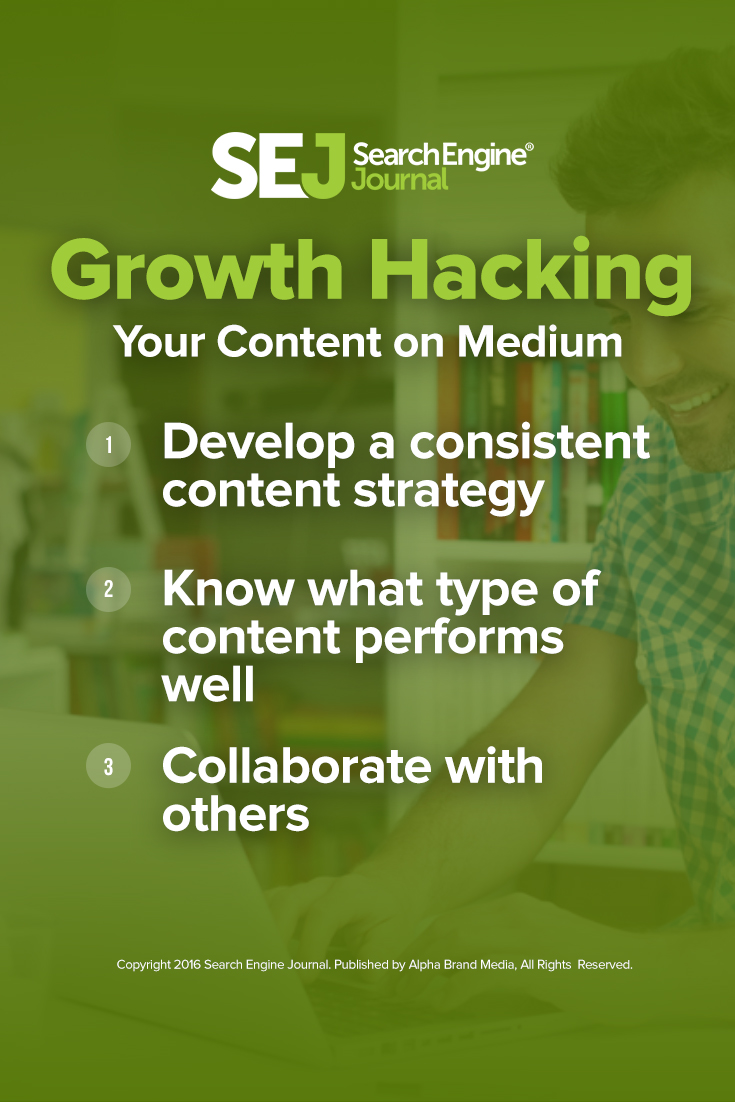 Image Credits
Image Credits
Featured Image: stockasso/depositphotos
All screenshots by Anna Crowe. Taken July 2016.

